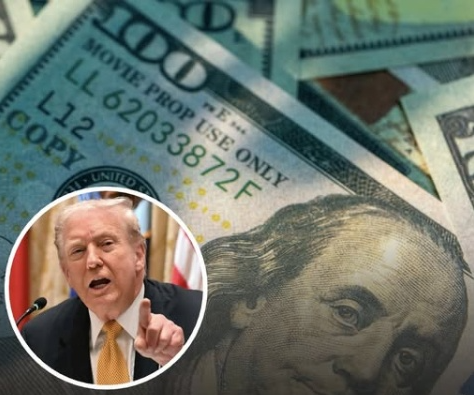When Donald Trump jumped onto Truth Social this week and announced that Americans would soon receive a $2,000 “dividend,” the news immediately set off a media firestorm. Supporters hailed it as bold and visionary, while critics dismissed it as unrealistic or even impossible. Regardless of opinion, one question dominated conversations nationwide: who exactly would qualify for the payout, and how would the money actually reach them?
Trump framed the dividend as a reward for what he claims is the economic windfall generated by his aggressive tariff policies. According to him, these tariffs have transformed the United States into “the richest, most respected country in the world,” creating soaring stock markets, healthier retirement accounts, and the long-awaited opportunity to begin paying down the national debt.
“This is all because of Tariffs,” Trump wrote on Truth Social. “People who oppose them are FOOLS. We are taking in trillions. The country has never been stronger.”
The promise itself was straightforward: $2,000 for “almost everyone.” But once the administration’s economic team began speaking publicly, the picture became more complicated.
Treasury Secretary Scott Bessent, who has quickly emerged as a key architect of Trump’s economic messaging, suggested that the payments might not be universal. Speaking on Fox & Friends, he offered the first concrete hint at eligibility criteria: families earning under $100,000 a year would likely qualify. Though his language was cautious, it reflected ongoing debates within the administration about the income ceiling. Bessent indicated that Trump favors a broad payout rather than a narrow one.
“Well, there are a lot of options here,” Bessent said. “The president’s talking about a $2,000 rebate for families making less than, say, $100,000. That’s one model being discussed.”
If that threshold becomes official, nearly 150 million Americans could qualify—almost double the reach of Trump’s previous stimulus checks, which had capped eligibility at $75,000 for single filers and $150,000 for couples. Analysts quickly began running the numbers. Erica York from the Tax Foundation estimated that at a $100,000 income cap, the total cost could reach approximately $300 billion—a staggering sum that raises immediate questions about funding.
Trump repeatedly emphasizes that tariff revenue will cover the payout. But the math is challenging. As of September 30, total U.S. tariff revenue stood at $195 billion—well short of the amount needed for a one-time $2,000 national dividend. The Treasury projects cumulative tariff income of $3 trillion over the next decade, but that assumes continued tariff hikes and spreads the funds across ten years. Moreover, much of that revenue is already allocated for other obligations. Using it for a massive cash payout would require borrowing against future income, even as the national debt approaches $38 trillion.
Still, Trump is undeterred. He has doubled down with new tariff proposals, including a 50% tax on imported cabinets and talk of a 100% tax on branded pharmaceuticals. Trump insists that these measures strengthen the U.S. economy without harming consumers—a point economists have repeatedly disputed. Politically, however, the message is clear: tariffs are paying for America’s resurgence, and citizens deserve their share.
Meanwhile, Bessent has begun tempering expectations. Speaking to ABC News, he suggested the $2,000 might not appear as a single lump sum. Instead, the administration could deliver it through a combination of tax adjustments spread throughout the year.
“It could come in lots of forms,” Bessent said. “No tax on tips, no tax on overtime, no tax on Social Security, deductibility of auto loans. These policies are already helping people, and we’re expanding that.”
Supporters argue this approach provides long-term relief rather than a one-time windfall, while critics contend it obfuscates the promise, turning the “$2,000 dividend” into a slogan more than a tangible benefit.
Press Secretary Karoline Leavitt sought to convey confidence when asked for details. She offered no concrete eligibility rules or timeline but emphasized Trump’s determination to deliver.
“The president made it clear he wants to make it happen,” she said. “His team of economic advisers is looking into it.”
Behind the scenes, the administration faces a delicate balancing act. On one hand, Trump has publicly committed to sending Americans money—a promise that energizes his base and pressures Congress, economists, and even his own cabinet. On the other, funding such a large program forces confrontation with the limits of tariff revenue, potential borrowing, and the political fallout of further increasing the national debt.
This tension is visible in Bessent’s careful statements. He knows tariffs alone cannot cover the payout, so he frames the plan around tax relief and incremental benefits. By doing so, the administration gains flexibility: if the math doesn’t add up, they can claim the $2,000 arrived indirectly through tax breaks rather than a direct check.
Trump, meanwhile, continues to frame the payments as a symbol of national strength—a “victory dividend” funded by the United States’ assertive economic posture. He portrays tariffs not as a burden but as evidence that the country has regained leverage in the global economy.
“We are the richest, most respected country in the world,” he wrote. “And this is only the beginning.”
Whether this is political bravado or a feasible economic strategy remains uncertain. Until the White House finalizes eligibility rules, Americans are left watching the back-and-forth between ambitious promises and the practical realities of federal budgeting.
One thing is clear: if the $100,000 threshold is adopted, nearly half the country could qualify. But if the payout comes through blended tax relief rather than a direct check, many may not recognize when or how the “dividend” reaches them. And if tariff revenue falls short, the administration may be forced to reduce payouts, borrow heavily, or defer costs to future budgets.
For now, all the country has is a promise, a handful of interviews, and a White House attempting to reconcile ambition with financial reality. The president insists the money is coming. His team says they’re working on it. And the American public waits to see whether this becomes a substantive economic policy or another headline fueled by hype.
